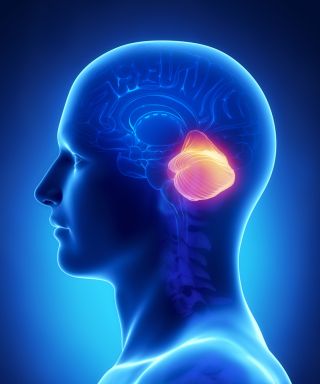Learn about brain health and nootropics to boost brain function
How the “Little Brain” Fuels Motivation and Addiction

Key points
First-of-its-kind research shows how the cerebellum modulates dopamine release within the basal ganglia.
Motivation and addiction are both fueled by dopamine activation in the basal ganglia’s substantia nigra.
Too little dopamine causes Parkinson’s disease. Stimulating the cerebellum may be a new treatment option.
The cerebellum (“little brain”) is tucked underneath the basal ganglia; it sits in the back of the skull below the cerebrum. Source: CLIPAREA l Custom media/Shutterstock
Neuroscientists have unearthed a previously unknown dopamine -driven neural pathway between the cerebellum (Latin for “little brain”) and reward centers in the basal ganglia that appears to fuel both the vigor of motivation and the intensity of addiction . These findings ( Washburn et al., 2024 ) were published on January 25 in Nature Neuroscience . The Cerebellum and Basal Ganglia: Separate but Interconnected
We’ve known for decades that the cerebellum helps to control and coordinate voluntary movements. Fluidity and grace when playing sports or doing everyday things like driving a car rely on the cerebellum’s coordination capacities. Damage to the cerebellum can impair fluid movements and well-timed motor control, often resulting in noticeable discombobulation and jerkiness, as seen in people with cerebellar ataxia. The basal ganglia is a subcortical structure in the midbrain located above the cerebellum and below the cerebral cortex. Source: CLIPAREA l Custom media/Shutterstock
As a completely separate subcortical brain structure, the basal ganglia’s substantia nigra region has traditionally been viewed as the brain’s go-no-go reward center that’s turned “on” by dopamine and turned “off” by a lack thereof. When the substantia nigra is flooded with dopamine, it turbocharges reward-seeking behaviors that often drive addiction and cue-induced relapse . Notably, a lack of dopamine in the substantia nigra is a hallmark of Parkinson’s disease.
Until now, the cerebellum’s muscle-coordinating powers and the basal ganglia’s reward-seeking influence were viewed as separate entities that weren’t directly interconnected or intertwined.
The recent discovery of a direct dopaminergic pathway between these two subcortical brain structures is the first direct evidence that the cerebellum modulates dopamine levels in the basal ganglia, influencing reward processing, movement initiation, and motivational vigorousness. New Discovery: The Cerebellum Controls Dopamine Release
The latest (2024) research by Farzan Nadim and colleagues suggests, for the first time, that the cerebellum modulates the release of dopamine into the basal ganglia’s substantia nigra pars compacta (SNc), a reward processing center involved in habit formation , addiction, motivation, and neurodegenerative diseases that affect voluntary movement, such as Parkinson’s disease.
“We are exploring a direct communication between two major components of our brain’s movement system, which is absent from neuroscience textbooks. These systems are traditionally thought to function independently,” Nadim said in a news release . “This pathway is physiologically functional and potentially affects our behaviors every day.”
This study in mice used state-of-the-art optogenetic activation techniques to hack into monosynaptic bilateral projections from the cerebellum to the substantia nigra that the researchers identified as modulating the release of dopamine in ways that drive reward-seeking behaviors. Stimulating or Suppressing the Cerebellum Affects Motivation and Movement
When the scientists shut down this cerebellum>SNc pathway and blocked dopamine signaling from the cerebellum to the basal ganglia’s substantia nigra using optogenetics, motivation to perform voluntary movements necessary to obtain a reward evaporated.
Conversely, when this dopamine-producing pathway was stimulated, it increased the vigor of mice’s motivation to seek rewards. The cerebellum also seemed to attach a higher value to the reward in real-time, which led to mice intensely pursuing a potentially addictive substance and giving them the dopamine-fueled motivation to do so.
More research is needed. But someday, in humans, shutting down this cerebellum-rooted pathway with targeted medications might mitigate addiction. In terms of daily physical activity, finding drug-free, holistic ways to activate the cerebellum’s dopamine-producing pathway could increase people’s motivation to seek exercise, not avoid it.
Theoretically, stimulating the cerebellum with transcranial magnetic stimulation or other therapeutic techniques could jumpstart dopamine production in the substantia nigra in ways that might help people with Parkinson’s disease. Next Steps: Focus on Parkinson’s Disease Treatment Options
“This pathway seems very important to our vigor of movement and speed of cognitive processes,” Nadim says. “Parkinson’s patients not only suffer from suppression of movement but apathy in some cases. The cerebellum’s location at the back of the brain makes it a much easier target for novel therapeutic techniques.”
After establishing that the cerebellum can directly excite the substantia nigra’s dopamine neurons, the researchers’ next step is to explore how stimulating this pathway and jumpstarting dopamine activity in the basal ganglia might relieve Parkinson’s disease symptoms.
References
Samantha Washburn, Maritza Oñate, Junichi Yoshida, Jorge Vera, Ramakrishnan Bhuvanasundaram, Leila Khatami, Farzan Nadim & Kamran Khodakhah. “The Cerebellum Directly Modulates the Substantia Nigra Dopaminergic Activity.” Nature Neuroscience (First published: January 25, 2024) DOI: 10.1038/s41593-023-01560-9
Read more at www.psychologytoday.com